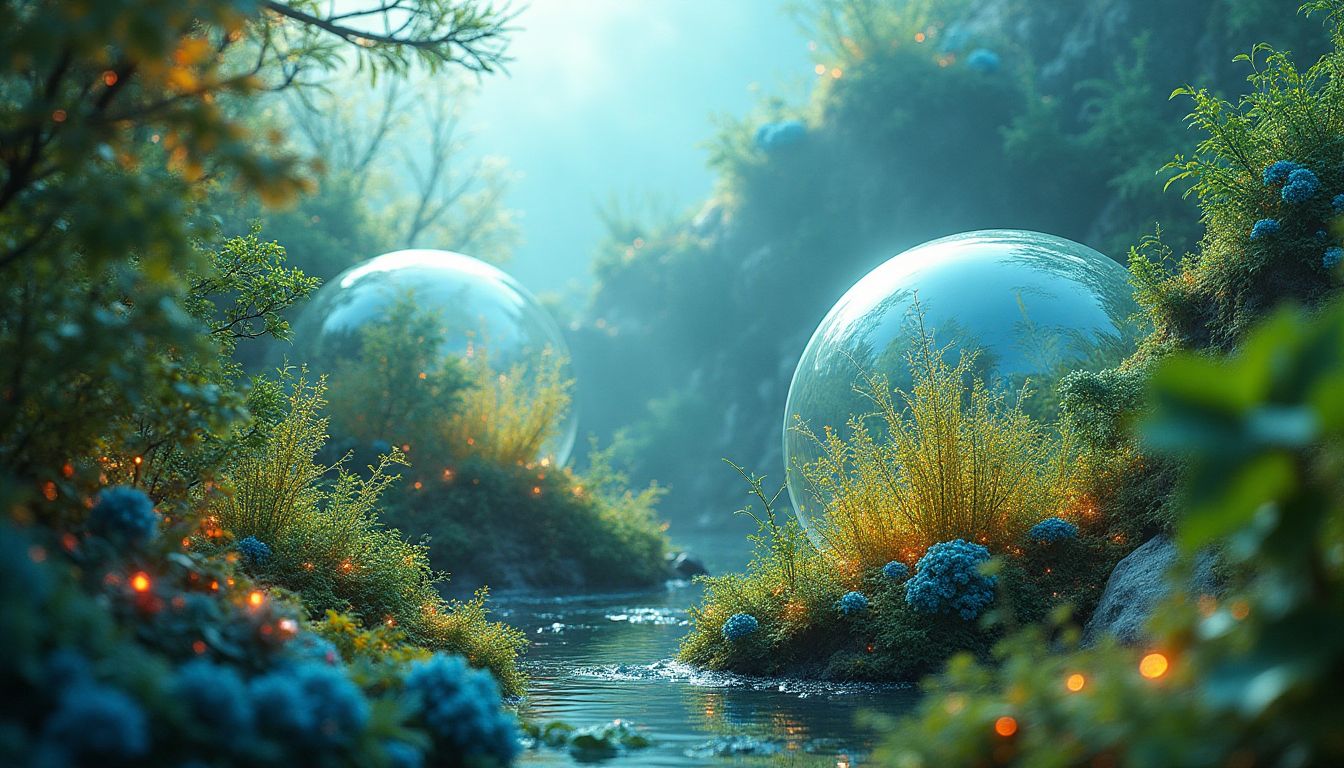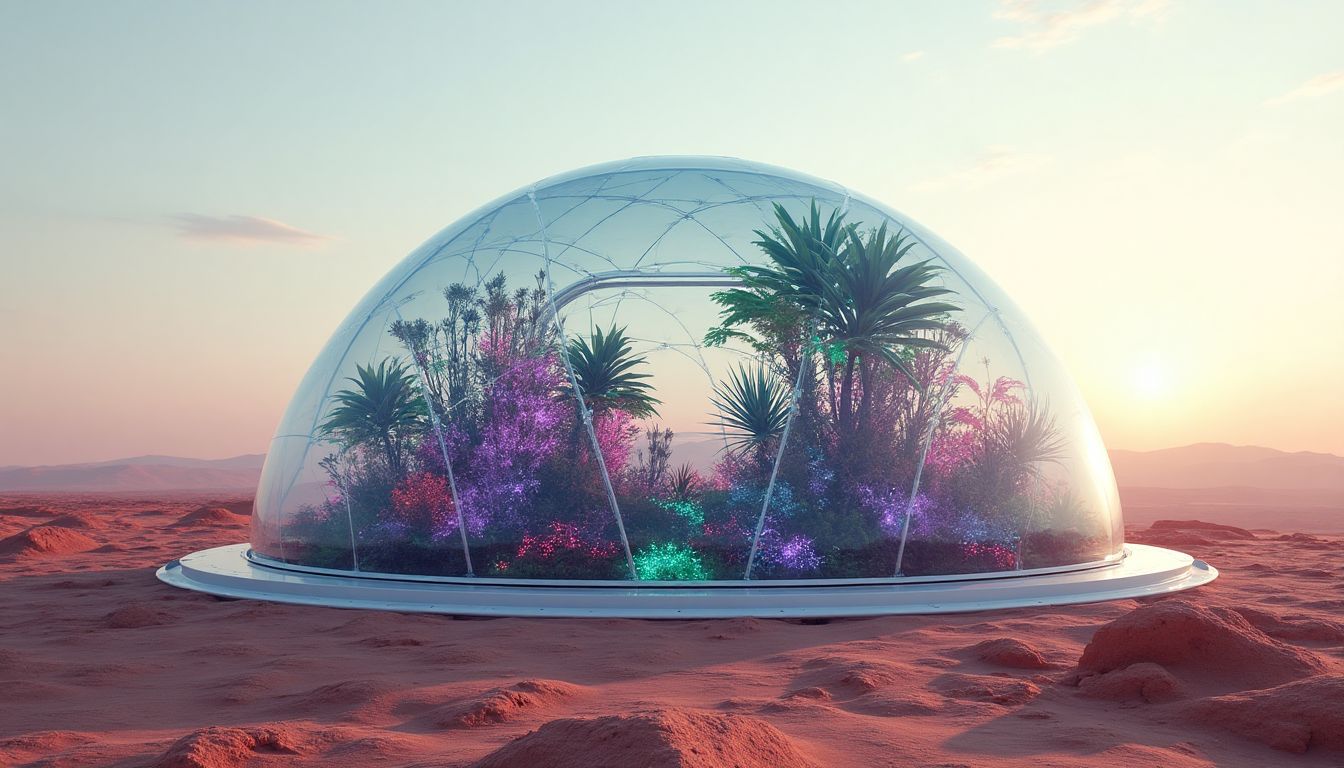Introduction: The Dream of Interstellar Utopia
The limits of my language mean the limits of my world. – Ludwig Wittgenstein
As we explore the stars, the boundaries of our language—and subsequently our ideas—expand beyond Earthly frontiers. In this grand journey to cosmic neighborhoods, we dream about engineering entire ecosystems in the void of space. Imagine crafting not merely habitats, but thriving biospheres on celestial bodies like the Moon or Mars. It's a quest that could redefine our species, fueled by the twin engines of bioengineering and artificial intelligence (AI).
How, you might ask, could AI venture into the realm of creating life beyond Earth? The path to this audacious goal is being paved by thinkers like Stephen Hawking, who reminded us of the importance of becoming a spacefaring civilization; Natasha Vita-More, whose works in transhumanism speak to stretching our boundaries; and Carl Sagan, who dreamed of worlds beyond our own.
This article delves into just how we might sculpt these ecosystems, discussing how AI, with its algorithms and cognitive prowess, could become a linchpin in forging these dynamic spaces from the raw material of dreams.
The Fundamental Principles of Ecosystem Engineering
Humanity stands at the cusp of what might be our next grand adventure: turning barren cosmic landscapes into lush, viable ecosystems. At the very core of this undertaking lies the principle of ecosystem engineering. This isn't just about transplanting Earthly life forms to Mars or the Moon like some kind of interstellar housewarming gift. No, it's about shaping entirely new systems capable of sustaining life.
Adaptation and Resilience
To succeed, these engineered ecosystems must be as hardy as the foliage of a cactus in the desert. We're talking about systems that can adapt—to the harsh, radiation-filled world of space where nights are colder than your freezer. In these foreign affronts, resilience is key. Researchers are engineering plants and microorganisms with the mettle of superheroes, employing techniques like CRISPR to tweak genes. The goal? Cultivating life that can thrive amidst unpredictable cosmic conditions.
Biogeochemical Cycles in Artificial Systems
Creating a thriving bioengineered ecosystem isn't just slapping some moss on an alien rock and calling it a day. Oh no, science calls for a perfectly choreographed ballet of biogeochemical cycles. Imagine carbon and nitrogen—invisible players—swirling through the environment like an elegant cosmic dance. For these ecosystems, getting the cycles right is akin to a perfectly baked soufflé in a zero-gravity kitchen. It's no small feat, but the potential rewards are astronomically tantalizing.
In essence, ecosystem engineering is the toolkit, and adaptation and resilience are the art of space horticulture. With these fundamentals, humanity can begin sketching life out of the cosmic blank canvas, all with a little help from our AI friends.
Current Technologies and Research in Bioengineering
The field of bioengineering is advancing quickly, with CRISPR, genetic manipulation, and synthetic biology leading the charge. These technologies are like the Swiss Army knife of modern science, offering tools for tweaking, tuning, and even cooking up life as we know it (or maybe as we don't know it yet).
CRISPR and Genetic Manipulation
Imagine being able to edit genes as easily as cutting and pasting text on your computer. That's CRISPR! It's a revolutionary tool that allows scientists to make precise changes to the DNA of living organisms. This has massive implications for creating plants and animals that can survive in space. I mean, who knew we'd be talking about genetically enhanced space broccoli?
Synthetic Biology: Creating Life from Scratch
If you thought CRISPR was impressive, wait until you hear about synthetic biology. It's like the "Build-a-Bear" of the life sciences but with microbes and plants. Scientists aim to design synthetic organisms perfectly tailored to space-life challenges. These critters could recycle waste, produce food, and even help terraform alien planets. Who would have thought a bunch of labs is the breeding ground for the space cowboys of tomorrow?
Designing Self-Sustaining Ecosystems for Space
Designing ecosystems for space habitats is like solving a Rubik's cube in zero gravity—tricky, but incredibly cool. The key questions are all about resources, lifeforms, and stability.
Resource Utilization and Recycling
To make a space colony sustainable, waste not, want not is the mantra. Think of it like living in a tiny house but in space. Everything must be reused, repurposed, and recycled. From air and water to organic waste, ensuring nothing goes to waste is vital. It's about closing the loop—a cosmic version of "Reduce, Reuse, Recycle."
Biodiversity and Stability
Earth's ecosystems thrive on diversity. More species mean more resilience! Now take that to a space habitat where the margin for error is smaller than a Martian's pinky finger. The right mix of organisms ensures stability—like having a tight-knit group of friends who each bring their unique skill to your alien birthday party. This means carefully choosing plants, animals, and microbes to create a balanced and adaptable ecosystem that can handle everything the universe throws its way.
Case Studies: Success Stories of Ecosystem Engineering
Peering into the earthly realm offers unique insights into the burgeoning field of ecosystem engineering—earth-based projects that mimic the very conditions future space habitats might endure.
NASA's Veggie Project on the ISS
Let's kick things off with NASA's Veggie Project aboard the International Space Station (ISS). This pioneering experiment is like a cosmic garden blooming in microgravity. Can we actually grow crops in outer space? The answer, surprisingly, is yes! Onboard the ISS, scientists are fine-tuning methods to cultivate plants in space—a vital step toward sustainable living on other planets.
The Veggie Project is more than just a quest for fresh greens; it's a beacon of hope for interstellar sustainability. By unearthing tricks for plant adaptation to weightlessness and other alien conditions, NASA lays the groundwork for future colonies on Mars. Fascinated by NASA's insights? Read more on their mission page.
The Mars Society's Mars Base Project
Jet-setting on a Martian voyage would feel incomplete without a nod to the Mars Society. Their Mars Base Project doesn't just simulate; it captivates. Imagine a prototype Martian colony—complex structures camouflaged in red hues, built purposefully under the gaze of Earth's own deserts. These simulations facilitate real-world prep for future explorations.
By intertwining knowledge from every possible domain—architecture, geology, agriculture, and more—the Mars Society crafts cohesive dreamscapes that turn potential craters into cornucopias of life. Explore the incredible work done at their official website.
Ethical Considerations and Risks of Bioengineering Ecologies
Every great breakthrough births a new era of ethical queries, and ecosystem engineering for space habitats is no exception. The moral quandaries hover like unseen asteroids.
Environmental Impacts
Picture this: a bioengineered organism takes root on a foreign planet. What could go wrong? A potential downward spiral for unsuspecting life forms. The introduction of non-native species is like rolling dice—betting against nature's enduring balance.
- Biodiversity Disruptions: These could throw alien ecosystems into chaos, culminating in unintended consequences like extinction events.
- Planetary Invasions: Organisms could outcompete and overshadow native species, leading to unforeseen complexities.
Perhaps we're playing planetary poker, but with precious environments at stake. Unravel deeper ethical debates in ecology on Oxford Academic.
Human Dependency on Artificial Ecosystems
The specter of reliance looms large. Should humans become tethered to artificial, space-age ecosystems, they face the paradox of independence—unfamiliar reliance on machines to synthesize breathable air or cultivate sustenance.
- Technology Reliance: Automated systems with AI integrations could bolster or hobble human autonomy, leading to technological tethering.
- Environmental De-sensitization: A growing detachment from natural cues could emerge—akin to Earth-dwellers forgetting the thrill of autumn's first chill.
Are our ambitions to survive the very ties that bind? Find truths unveiled in Cambridge's discourse on environmental ethics.
As we step onto new horizons, our principles must steer the ship. Do we dare to embark, unencrypted and unanchored?
AI Solutions: Shaping the Future of Bioengineered Ecosystems
The integration of Artificial Intelligence (AI) into the design and management of bioengineered ecosystems heralds a new era in space exploration. AI can unlock potential that humans might otherwise overlook, revolutionizing our understanding of these artificial environments. Here’s how:
- Simulation of Ecosystem Dynamics: Imagine an AI capable of creating complex models of ecosystems tailored for extraterrestrial environments. Using sophisticated algorithms, AI can simulate various ecosystem configurations, predicting how different organisms might interact—plant, animal, and microorganisms—ensuring a balanced system. This approach not only saves time and resources but allows scientists to test theories without the need for physical trials. AI simulation tools like Complexity Explorer or AnyLogic can serve as essential starting points for such models.
- Machine Learning Algorithms: By employing machine learning algorithms, we pave the way for responsive bioengineered ecosystems that can adapt over time. These systems can collect data from their environments, learn from it, and make necessary adjustments on-the-fly. For instance, an AI system could track nutrient levels and plant health, adjusting water and nutrient provision automatically to optimize growth, much like a Watson Health initiative implements data-driven solutions. Analyzing and utilizing this data reduces human error and enhances ecosystem stability.
- Optimization of Resource Management: One of the biggest challenges in space habitats is efficient resource use. AI excels at this task; it can process enormous datasets to determine the most effective ways to manage water, nutrients, and energy. For example, AI could predict the supply needs of various crops based on growth phases, minimizing waste throughout the ecosystem. This data-driven approach goes so far as to revolutionize how we approach agriculture, reminiscent of techniques employed by precision agriculture firms on Earth that leverage AI to optimize farming.
Actions Schedule/Roadmap: From Groot's Sapling to the Galactic Garden
This roadmap outlines a comprehensive plan designed for scientists, governments, and organizations aiming to engineer bioengineered ecosystems for space habitats. By targeting objectives from immediate actions to long-term goals, this timeline capitalizes on current innovations in technology:
Day 1
Establish an interdisciplinary team comprising experts in genetics, ecology, engineering, and AI. Consider organizations such as NASA, ESA, and leading universities like MIT and Stanford to enrich the team’s diversity of thought.
Day 2
Hold a major kickoff meeting to establish specific objectives, roles, timelines, and deliverables. Emphasize the importance of open communication and collaboration.
Week 1
Commence thorough research into current bioengineering technologies, focusing on tools used for simulations and genetic editing. Rely on collaboration with biotech firms such as Verdant Biosciences and others focused on synthetic biology.
Week 2
Conduct expert workshops featuring leaders from the fields of synthetic biology and adaptive organisms. This could include inviting experts from companies like Ginkgo Bioworks, renowned for their innovative approaches to organism design.
Month 1
Develop prototypes for bioengineered organisms customized for extraterrestrial survival. Utilize findings from initial studies to refine your prototypes, optimizing growth conditions and resilience.
Month 2
Execute controlled tests on the prototypes, analyzing performance metrics such as growth rate, efficiency, and adaptability. Use feedback to iterate and adapt as necessary, employing the AI algorithms discussed earlier.
Month 3
Consolidate your findings and continue to refine ecosystem models based on gathered data, ensuring durability and efficiency under varying simulated conditions.
Year 1
Begin habitat simulation in microgravity environments, mimicking the conditions of space. Partner with organizations such as the International Space Station for access to testing facilities.
Year 1.5
Launch field tests in biodomes designed to simulate extraterrestrial conditions, evaluating how the bioengineered organisms interact in a closed-loop environment. Objective assessments can be obtained through collaborating with institutions like BioNautilus.
Year 2
Review the accumulated data, evaluate ecosystem viability, and prepare for interplanetary deployment. This phase includes consultations with international space organizations to finalize plans for human testing and real-world implementation.
Conclusion: The Dawn of a Multi-Planetary Era
As we explore the cosmos, the merging of AI, bioengineering, and ecological science could fundamentally alter our ability to thrive beyond Earth. Imagine lush, vibrant ecosystems on distant planets, pulsating with life—a dream once confined to the bounds of science fiction. Bold ideas will be essential, fusing human creativity with cutting-edge technology. The time to act is now. For a multi-planetary future, we must harness our innovative capabilities and responsibly navigate the ethical implications of this brave new world. The journey ahead is fraught with challenges, yet filled with promise. Are we ready to commit ourselves to the endeavor of transforming barren horizons into flourishing biomes? What role do you envision AI playing in our journey to create a habitable universe? We invite you to share your thoughts in the comments below.
FAQ: Bioengineered Ecosystems for Space Habitats
-
What is a bioengineered ecosystem?
A bioengineered ecosystem is an artificial environment created to support life. It uses designed biological and ecological processes to help plants, animals, and even humans live in places where they normally wouldn’t survive, like in space.
-
How can AI assist in creating ecosystems for space habitats?
Artificial Intelligence (AI) can help in many ways, such as:
- **Modeling Ecosystems:** AI can simulate how different life forms interact in a closed system.
- **Optimizing Resources:** It ensures we use water, air, and nutrients wisely to keep everything balanced.
- **Learning from Data:** AI can analyze feedback and improve designs over time.
-
What are some risks of bioengineering ecosystems?
When creating these ecosystems, there are some potential dangers to think about:
- **Unintended Consequences:** Bioengineered organisms could affect alien environments in unexpected ways.
- **Dependence on Technology:** If humans rely too much on these artificial systems, they could struggle to survive without them.
- **Ethical Concerns:** We must think about whether it’s right to create life in a new place and how it might impact existing ecosystems.
-
What are some examples of bioengineering success on Earth?
A notable example is NASA's Veggie Project on the International Space Station (ISS). This project helps scientists understand how to grow food in space, which is crucial for future missions to Mars and beyond.
-
Is there a timeline for deploying these ecosystems in space?
While specific timings can change, researchers hope to start testing bioengineered ecosystems in controlled environments soon. The long-term goal is to establish these systems on other planets within the next few decades.
-
What kinds of organisms might be used in these ecosystems?
Scientists might choose organisms that can really help in harsh environments. These could include:
- **Hardy Plants:** Like algae or certain types of cacti that need little water.
- **Bacteria:** That can break down waste and recycle nutrients.
- **Insects:** Like mealworms or flies that can help with food production and decomposition.
-
Why is biodiversity important in these ecosystems?
Biodiversity makes ecosystems stronger and more stable. The more different types of organisms there are, the better the system can adapt to changes and challenges. For instance, if one type of plant is affected by a disease, another type might be unaffected, which helps keep the ecosystem going.
-
How will we know if these ecosystems will work on other planets?
Scientists plan to conduct many tests right here on Earth first. They will create smaller versions of these ecosystems in labs and greenhouses. By studying their interactions and resilience, scientists can learn what works and what doesn’t before sending anything to space.
Wait! There's more...check out our gripping short story that continues the journey: Arkadia
Disclaimer: This article may contain affiliate links. If you click on these links and make a purchase, we may receive a commission at no additional cost to you. Our recommendations and reviews are always independent and objective, aiming to provide you with the best information and resources.
Get Exclusive Stories, Photos, Art & Offers - Subscribe Today!





























Post Comment
You must be logged in to post a comment.